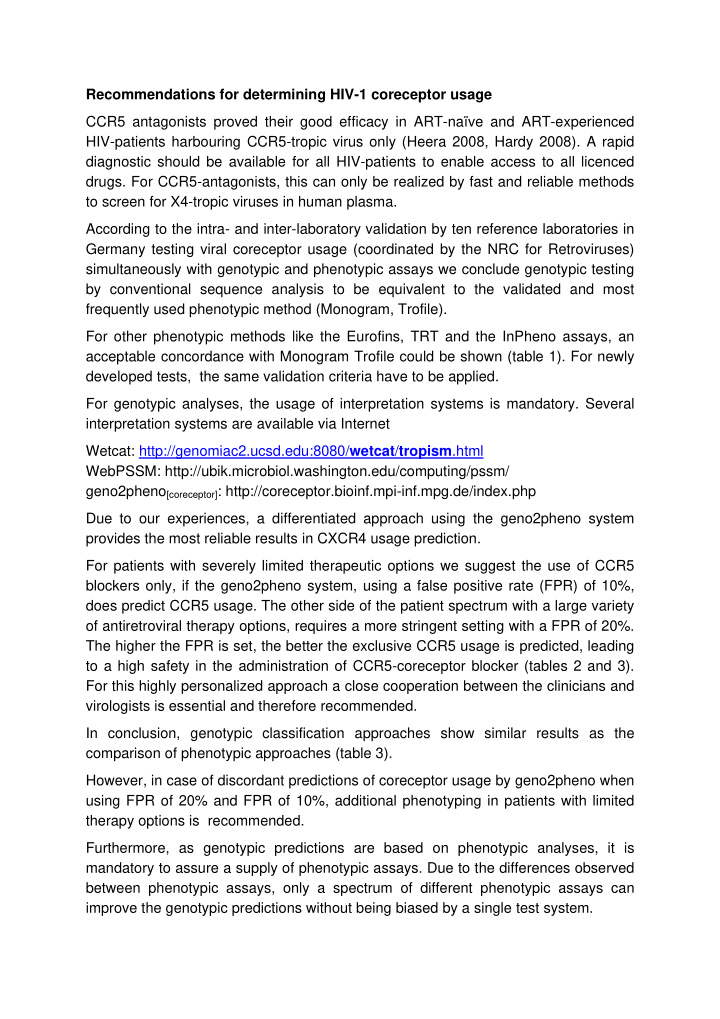



Recommendations for determining HIV-1 coreceptor usage CCR5 antagonists proved their good efficacy in ART-naïve and ART-experienced HIV-patients harbouring CCR5-tropic virus only (Heera 2008, Hardy 2008). A rapid diagnostic should be available for all HIV-patients to enable access to all licenced drugs. For CCR5-antagonists, this can only be realized by fast and reliable methods to screen for X4-tropic viruses in human plasma. According to the intra- and inter-laboratory validation by ten reference laboratories in Germany testing viral coreceptor usage (coordinated by the NRC for Retroviruses) simultaneously with genotypic and phenotypic assays we conclude genotypic testing by conventional sequence analysis to be equivalent to the validated and most frequently used phenotypic method (Monogram, Trofile). For other phenotypic methods like the Eurofins, TRT and the InPheno assays, an acceptable concordance with Monogram Trofile could be shown (table 1). For newly developed tests, the same validation criteria have to be applied. For genotypic analyses, the usage of interpretation systems is mandatory. Several interpretation systems are available via Internet Wetcat: http://genomiac2.ucsd.edu:8080/ wetcat / tropism .html WebPSSM: http://ubik.microbiol.washington.edu/computing/pssm/ geno2pheno [coreceptor] : http://coreceptor.bioinf.mpi-inf.mpg.de/index.php Due to our experiences, a differentiated approach using the geno2pheno system provides the most reliable results in CXCR4 usage prediction. For patients with severely limited therapeutic options we suggest the use of CCR5 blockers only, if the geno2pheno system, using a false positive rate (FPR) of 10%, does predict CCR5 usage. The other side of the patient spectrum with a large variety of antiretroviral therapy options, requires a more stringent setting with a FPR of 20%. The higher the FPR is set, the better the exclusive CCR5 usage is predicted, leading to a high safety in the administration of CCR5-coreceptor blocker (tables 2 and 3). For this highly personalized approach a close cooperation between the clinicians and virologists is essential and therefore recommended. In conclusion, genotypic classification approaches show similar results as the comparison of phenotypic approaches (table 3). However, in case of discordant predictions of coreceptor usage by geno2pheno when using FPR of 20% and FPR of 10%, additional phenotyping in patients with limited therapy options is recommended. Furthermore, as genotypic predictions are based on phenotypic analyses, it is mandatory to assure a supply of phenotypic assays. Due to the differences observed between phenotypic assays, only a spectrum of different phenotypic assays can improve the genotypic predictions without being biased by a single test system.
Since there is a fast progression in the field coreceptor tropism testing, the details of this recommendation will be updated regularly. Table 1 : Agreement between Trofile and TRT (Skrabal et al. 2007) Agreement Trofile vs. FNR TRT 85,1 % 28,0 % Agreement TRT vs. FNR Trofile 85,1 % 12,5 % Table 2 : German validation study: Agreement between genotypic tropism results (using g2p classification with different false positive rates (FPR)) and phenotypic results (Trofile); N=234 samples (all laboratories). False negative rate Method Concordant results (%) (FNR in %) * G2P 20 % FPR 76.06 24.66 G2P 15 % FPR 76.49 30.14 G2P 10 % FPR 80.34 35.62 G2P 5 % FPR 83.76 43.84 G2P 2.5 % FPR 79.91 61.64 G2P 1 % FPR 76.06 75.34 * named R5-tropic by g2p but X4-tropic by Trofile Table 3 : Agreement between genotypic classification methods and Trofile results (N=103, Labor Berg). Method Concordant results [%] FNR (%) G2p 20 % FPR 77 20 G2p 15 % FPR 77 26 G2p 10 % FPR 77 32 G2p 5 % FPR 82 45 G2p 2.5 % FPR 82 58 G2p 1 % FPR 77 74 WepPSSM 82 38 WETCAT:C4.5 74 84
WETCAT: C4.5 p8 and p12 74 87 Wetcat: Part 78 55 Wetcat: SVM 77 52 Wetcat: Charge 82 58 one of the algorithms X4 67 10 References Hardy D, Reynes J, Konourina I, Wheeler D, Moreno S, van der Ryst E, Towner6 W, Horban A, Mayer H, Goodrich J. Efficacy and Safety of Maraviroc plus Optimized Background Therapy in Treatment-experienced Patients Infected with CCR5-Tropic HIV-1: 48-Week Combined Analysis of the MOTIVATE Studies. 15 th CROI 2008, Boston, MA,USA. Abstract 792. Heera J, Saag M, Ive P, Whitcomb J, Lewis M, McFadyen L, Goodrich J, Mayer H, van der Ryst E, and Westby M. Virological Correlates Associated with Treatment Failure at Week 48 in the Phase 3 Study of Maraviroc in Treatment-naive Patients. 15 th CROI 2008, Boston, MA,USA. Abstract 40LB. Skrabal, K.; Low, A. J.; Dong, W.; Sing, T.; Cheung, P. K.; Mammano, F. & Harrigan, P. R. (2007), 'Determining human immunodeficiency virus coreceptor use in a clinical setting: degree of correlation between two phenotypic assays and a bioinformatic model.', J Clin Microbiol 45 (2), 279--284.
Recommend
More recommend